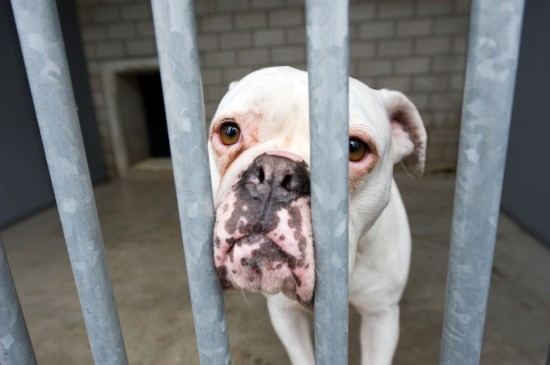
Periodontal disease (problems in the area around the teeth) is
one of the most common health problems in companion animals. It
is estimated that 80 per cent of dogs and 70 per cent of cats
older than 3 years of age suffer from some level of periodontal
disease. Just as in the human mouth, the process begins with
plaque, which is made of salivary proteins and bacteria. The
bacteria irritate the gum, causing an inflammatory reaction,
which is known as gingivitis. If the plaque is removed by
toothbrushing, the gingivitis resolves and the gums return to
normal. If the plaque is not removed, it hardens into “tartar”
or “calculus.” The calculus provides a rough surface for even
more plaque to accumulate. Bad breath may be noted. Inflammation
continues in the gums and can also affect any bone in the area,
resulting in destruction of the bone around the tooth roots.
Eventually, the teeth become loose and may fall out.
In addition to tooth loss, periodontal disease has other, more
serious, consequences. The millions of bacteria present in an
unhealthy mouth can spread to other parts of the body, such as
the heart, lungs, kidneys, and liver, causing disease in these
vital organs. In small breed dogs with tiny jawbones, the bone
destruction caused by periodontal disease can weaken the jawbone
enough to cause a fracture.
The good news is that periodontal disease is completely
preventable! Removing the plaque reverses the inflammatory
process in the gingiva and restores the gums to health. As we
know from our own experience, plaque removal is best achieved by
brushing the teeth. Dog and cat teeth are not as close together
as ours are, so flossing is not necessary. However, in order to
be effective, brushing must be done every day. A soft-bristled
toothbrush with a small head is the best tool for removing
plaque from your dog’s or cat’s teeth. Special pet toothpaste is
available in flavors such as “malt,” “poultry,” and “seafood” to
help your pet enjoy the experience. Human toothpaste can cause
stomach upset if pets swallow the toothpaste. Because dogs and
cats rarely get caries (cavities), fluoride is not necessary.
Feeding special diets such as Hill’s T/D and encouraging chewing
activity with toys such as the Dental Kong also help reduce
plaque accumulation.
Daily toothbrushing, special diets, and chewing activity help
prevent plaque from hardening into calculus. Once calculus is
present, however, a professional cleaning is required. Although
the bone destruction caused by periodontal disease cannot be
reversed, the inflammatory process can be stopped or slowed with
proper treatment. Routine periodontal treatment involves sonic
or ultrasonic scaling above and below the gumline. Because your
veterinarian cannot simply tell your pet to “hold still,” these
procedures require that your pet be placed under anesthesia.
Anesthesia always has inherent risks. However, your veterinarian
is experienced and the risk related to anesthesia is minimal. To
further minimize this risk to your pet, your veterinarian may
recommend blood and other tests prior to sedation. These are
done before anesthesia to reveal any problems that may not be
obvious from a physical examination. Dental x-rays are important
to determine the amount of bone destruction present. Teeth with
significant bone loss may benefit from periodontal surgery.
Extraction is usually recommended for teeth with little bone
support remaining.
In addition to periodontal disease, cats can develop
“resorptive” lesions, which can lead to pain and difficulty
eating. These lesions are sometimes called “cavities,” but they
do not result from bacteria and sugars as people’s cavities do.
Cells such as the ones responsible for removing deciduous (baby)
tooth roots become activated and start to attack permanent
teeth. The result is destruction of large amounts of the tooth
and exposure of the nerve, or pulp, inside the tooth. Pain may
be evident in behavior such as pawing at the face, dropping
food, drooling, or reluctance to eat. The areas of destruction
can be seen on careful examination of the teeth and with the use
of dental x-rays.
Resorptive lesions cannot be filled like human cavities, as the
cells continue to work under the filling to destroy the
remaining tooth. The current recommendation for affected teeth
is extraction. At this time, because we do not know why the
cells become activated, there is no known way to prevent
resorptive lesions. Regular examinations by your veterinarian
will help to detect these lesions early, before they cause
significant pain to your cat.
By brushing your pet’s teeth every day and scheduling regular
examinations with you veterinarian, you can provide your
companion with a lifetime of fresh breath, clean teeth, healthy
gums, and strong jawbones. In addition, you will be helping to
keep your pet pain free and in overall good health.
The above is general veterinary information. Do not begin
any course of treatment without consulting your regular
veterinarian. All animals should be examined at least once every
12 months.
 My Dog Suffers From Hip Dysplasia, Can They Still Compete?
My Dog Suffers Fr
My Dog Suffers From Hip Dysplasia, Can They Still Compete?
My Dog Suffers Fr
 A Short Guide To Mating For Successful Dog Breeding
A Short Guide To
A Short Guide To Mating For Successful Dog Breeding
A Short Guide To
 Some Horse And Pony Basics - Colours, Types And Markings
Some Horse And Po
Some Horse And Pony Basics - Colours, Types And Markings
Some Horse And Po
 How To Choose The Right Dog For You From A Rehoming Shelter
How To Choose The
How To Choose The Right Dog For You From A Rehoming Shelter
How To Choose The
 German Shepherd - Subluxation and Other Problems of the Spine
German Shepherd - Subluxation and Other Problems of the Sp
German Shepherd - Subluxation and Other Problems of the Spine
German Shepherd - Subluxation and Other Problems of the Sp
Copyright © 2005-2016 Pet Information All Rights Reserved
Contact us: www162date@outlook.com